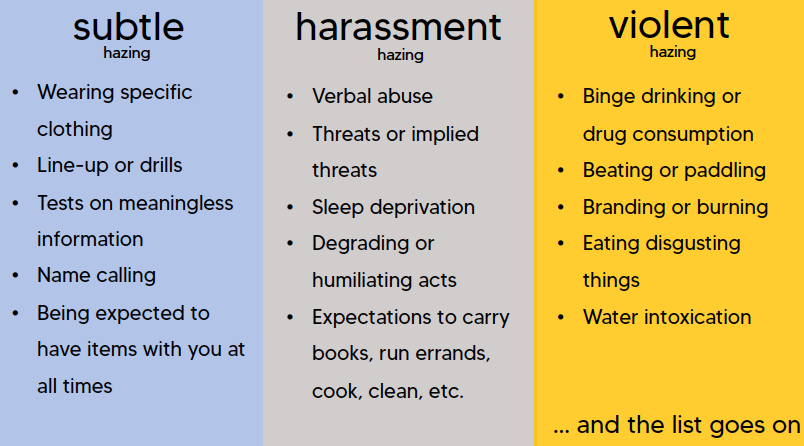Hazing is defined and prohibited by state law, as well as campus and local policies. Learn more by reading more below.
UC Systemwide and Campus Policy on Hazing
The State of California and the University of California have expressly and repeatedly asserted their opposition to hazing and preinitiation activities which do not contribute to the positive development and welfare of the individuals involved.
The systemwide UC Policies Applying to Campus Activities, Organizations and Students (PACAOS) Policy on Student Conduct and Discipline states:
“Chancellors may impose discipline for the commission or attempted commission (including aiding or abetting in the commission or attempted commission) of the following types of violations by students, as well as such other violations as may be specified in campus regulations:
…
Participation in hazing or any method of initiation or pre-initiation into a campus organization or other activity engaged in by the organization or members of the organization at any time that causes, or is likely to cause, physical injury or personal degradation or disgrace resulting in psychological harm to any student or other person.”
Laws on Hazing
California Law
SEC. 3. Section 245.6 of the Penal Code reads:
…
(a) It shall be unlawful to engage in hazing, as defined in this section.
(b) “Hazing” means any method of initiation or preinitiation into a student organization or student body, whether or not the organization or body is officially recognized by an educational institution, which is likely to cause serious bodily injury to any former, current, or prospective student of any school, community college, college, university, or other educational institution in this state. The term “hazing” does not include customary athletic events or school-sanctioned events.
(c) A violation of this section that does not result in serious bodily injury is a misdemeanor, punishable by a fine of not less than one hundred dollars ($100), nor more than five thousand dollars ($5,000), or imprisonment in the county jail for not more than one year, or both.
(d) Any person who personally engages in hazing that results in death or serious bodily injury as defined in paragraph (4) of subdivision (f) of Section 243 of the Penal Code, is guilty of either a misdemeanor or a felony, and shall be punished by imprisonment in county jail not exceeding one year, or by imprisonment pursuant to subdivision (h) of Section 1170.
(e) The person against whom the hazing is directed may commence a civil action for injury or damages. The action may be brought against any participants in the hazing, or any organization to which the student is seeking membership whose agents, directors, trustees, managers, or officers authorized, requested, commanded, participated in, or ratified the hazing.
(f) Prosecution under this section shall not prohibit prosecution under any other provision of law.
Examples of Hazing

Examples of Subtle Hazing
Subtle hazing includes behaviors that emphasize a power imbalance between new members/rookies and other members of the group or team. Termed “subtle hazing” because these types of hazing are often taken-for-granted or accepted as “harmless” or meaningless. Subtle hazing typically involves activities or attitudes that breach reasonable standards of mutual respect and place new members/rookies on the receiving end of ridicule, embarrassment, and/or humiliation tactics. New members/rookies often feel the need to endure subtle hazing to feel like part of the group or team. (Some types of subtle hazing may also be considered harassment hazing).
- Deception
- Assigning demerits
- Silence periods with implied threats for violation
- Deprivation of privileges granted to other members
- Requiring new members/rookies/initiates to perform duties not assigned to other members
- Socially isolating new members/rookies
- Line-ups and Drills/Tests on meaningless information
- Name calling
- Requiring new members/rookies to refer to other members with titles (e.g. “Mr.,” “Miss”) while they are identified with demeaning terms
- Expecting certain items to always be in one’s possession
Examples of Harassment Hazing
Behaviors that cause emotional anguish or physical discomfort in order to feel like part of the group. Harassment hazing confuses, frustrates, and causes undue stress for new members/rookies. (Some types of harassment hazing can also be considered violent hazing).
- Verbal abuse
- Threats or implied threats
- Asking new members to wear embarrassing or humiliating attire
- Stunt or skit nights with degrading, crude, or humiliating acts
- Expecting new members/rookies to perform personal service to other members such as carrying books, errands, cooking, cleaning etc
- Sleep deprivation
- Sexual simulations
- Expecting new members/rookies to be deprived of maintaining a normal schedule of bodily cleanliness.
- Be expected to harass others
Examples of Violent Hazing
Behaviors that have the potential to cause physical and/or emotional, or psychological harm.
- Forced or coerced alcohol or other drug consumption
- Beating, paddling, or other forms of assault
- Branding
- Forced or coerced ingestion of vile substances or concoctions
- Burning
- Water intoxication
- Expecting abuse or mistreatment of animals
- Public nudity
- Expecting illegal activity
- Bondage
- Abductions/kidnaps
UCI celebrates a positive and healthy culture where hazing isn’t tolerated.